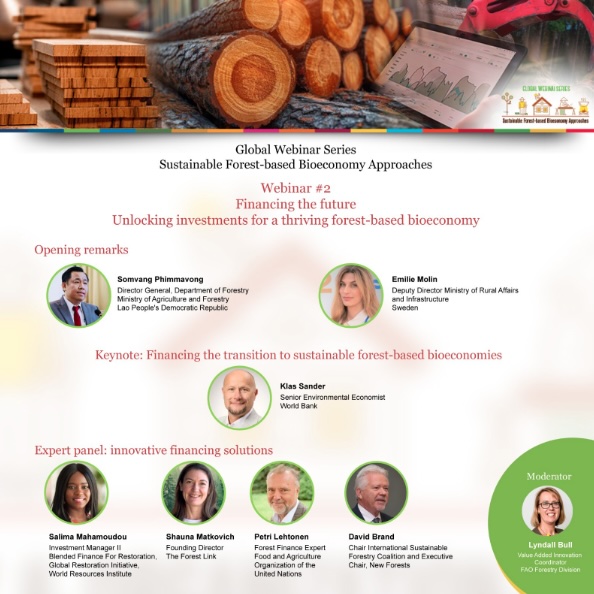I’m excited to share that I’ll be joining the second webinar in FAO’s global series on sustainable forest-based bioeconomy approaches. If you’re reading this on release day, there’s still time to register for the live webinar on Tuesday, April 29, 2025 at 15:00 CEST. If you miss it, the recording will be made available afterward.
Together with my fellow panelists: Salima Mahamoudou (WRI), Petri Lehtonen (FAO), and David Brand (Chair International Sustainable Forestry Coalition and Executive Chair, New Forests), we’ll dive deep into financial mechanisms—from innovative investment models to expanding climate finance and market-based solutions, particularly in the Global South. Unlocking these pathways is critical to building a resilient, sustainable forest-based bioeconomy.
In this article, I expand on my responses to two core questions I’ve been asked to address during the session:
- How can we attract patient capital, given the long gestation periods of forestry investments?
- What are the most effective strategies for mitigating and sharing the diverse risks in Global South forest investments?

Why Investors Are Drawn to Forest-Based Bioeconomies
Before addressing these questions, it’s important to recognize why investors are attracted to forests in the first place. I’ll focus primarily on investments in forest assets themselves, rather than downstream processing.
For institutional investors, carving out a small portion of their investment portfolio to real, forest assets, often put into the bucket of alternatives, forest assets provide diversification and inflation hedging. They are largely uncorrelated with other financial markets – and have the benefit of harvest flexibility – where harvests can often be put off in times of low wood prices, or conversely, accelerated in times of high wood prices (with caveats that we won’t get into). And to the point of delayed harvests, the forests continue to add value through their biological growth as long as the trees are standing.
While forestry is a long-term, relatively low-risk investment with stable returns, it’s not a high-return asset class. Increasingly, sustainability and impact objectives—especially those linked to climate, nature, and the circular bioeconomy—are major drivers for capital allocation to forests.
Patience in Long Gestation Forest Investments
Now the but. In developed wood markets, the characteristics of a low risk-low return forest investment strategy over long time horizons suits investors well. There are also often sufficient mature forest assets, where regular cashflows can be generated from regular harvests. However, in the global south, wood markets are often under-developed, and there are limited opportunities to invest in mature commercial forests – Despite the incredible impact potential. What this translates to is higher risk, related to the market dynamics – as there is generally no set point for wood prices, no premium for high quality or sustainability stamps like forest management certification, and there is often competition from informal or illegal wood markets. There is also risk related to tenure security, where informal or customary land rights exist, there is risk related to inexperience in forest management itself, and so on. However, where investors might be attracted to a high risk-high return strategy in the global south, we need to acknowledge that forest investments will almost never deliver on the high return piece.
So, we need to consider a couple of things: 1. Which investors are naturally aligned with the characteristics of global south forest-based bio-economies and 2. How can we address the concerns of a wider investor base who are put off by the long-time horizons, perceived risk and low returns to bring more capital to this much needed sector.
Which Investors Align with Global-South Forest-based Bio-economy Investments?
The most natural investors for forest-based bioeconomy opportunities in the Global South are those already focused on long-term, impact-driven outcomes. Development Finance Institutions (DFIs), particularly those based in regions with strong forest management traditions, have historically filled this role.
Some impact funds, mission-driven asset managers, and family offices with intergenerational strategies are also increasingly active. These investors value forests not only for returns, but for their contributions to climate stability, biodiversity, and sustainable economic development.
However, broadening the investor base will depend on tackling the structural challenges that limit investment today.
Strategies to Address Time Horizons and Liquidity Challenges
The concern over long time horizons in the global south stems less from the long-time horizon itself, but more from the illiquid nature of the assets over the investment period, of perceived risk and low returns. Let’s jump right in to discuss some ways to address these challenges in combination.
- Asset Maturity
One way to address concerns about long investment horizons is to focus on the maturity of forest assets. Brownfield investments—those where forests are already at or near harvest age—can generate earlier cashflows and help balance portfolio returns. However, mature assets are rare in the Global South. A practical approach is to combine brownfield and greenfield (young or new forest establishment) assets within a portfolio. Cashflows from mature forests can offset the longer development periods of new plantations, while greenfield projects continue to deliver strong additionality and impact. Another strategy is to invest in brownfield forests that offer expansion opportunities, creating a blend of immediate and future value within the same assets.
- Blended Finance
Blended finance remains one of the most effective ways to de-risk forestry investments and attract a broader range of capital. By combining concessional capital—such as public funds or philanthropic investment—with commercial capital, it’s possible to structure an investment where the concessional funders absorb more of the early-stage risk. This can be done through first-loss positions, subordinated returns, or guarantees. Blended structures can also be designed to compress timelines: concessional investors might fund greenfield establishment phases, with commercial investors committed to invest once assets have matured and cashflow generation is more certain. In both cases, blended finance helps realign risk and reward in ways that better match private investor expectations.
- Carbon Finance
The integration of carbon finance into forest investment models offers a critical tool for improving early-stage cashflows. High-quality afforestation, reforestation, or revegetation (ARR) projects can start generating verified carbon credits approximately five years after planting, providing revenue far earlier than traditional timber harvests, which, in the global south, may take 15–25 years depending on the region and species. However, carbon-financed forestry requires thoughtful project design to meet the increasingly stringent integrity standards of the voluntary and compliance markets. Where done successfully, layering carbon credits into a timber investment not only advances cashflow timelines but also enhances the overall environmental and social value of the project, making it more attractive to both investors and stakeholders.
Now, let’s dig deeper into the risk piece.
How to mitigate and share the risks associated with Global South Forest Investments
The risk piece, is bigger than the long-time horizon concern for attracting more capital to global-south forest assets. Yes, political, regulatory, market, and environmental are some of these – but there is also tenure, management risks and others like I mentioned above. Rightly ensued by the question – these risks are often too much for an investor to take on by themselves. Sharing the risks across different stakeholders is an excellent way to approach this and break one of the biggest barriers to entry. I suggest four ways to share the risk.
- Blended finance – As discussed earlier, blended finance structures allow concessional capital to absorb higher risks, creating space for market-rate investors to participate. Structures that offer first-loss protection, subordinate returns, or other risk-buffering mechanisms can make forest investments more attractive without distorting long-term sustainability goals.
- Partnerships and relationships – Beyond financial structuring, partnerships play a critical role in risk mitigation. Strategic alliances—such as forest businesses working with NGOs to address tenure security or social risks, or forest owners collaborating with processors through long-term supply agreements—can strengthen operational resilience. Similarly, government-industry cooperation, particularly around export policies and regulation of informal markets, can help create a healthier investment environment.
- Incentives – Positive incentives can further reduce investment risk by rewarding responsible practices. Examples include government premiums for certified wood, tax incentives for sustainable forest management, or bilateral donor programs tied to demonstrable regulatory improvements. Designing incentives around verified outcomes, rather than policy announcements alone, strengthens their credibility and impact.
- Insurance – Insurance remains a practical tool for protecting forest investments against specific risks. Options include political risk insurance (e.g., through MIGA), forest insurance against fire and natural disasters, and the emerging market for carbon insurance, which covers delivery risks for carbon credit projects or policy-related risks in carbon markets.
Tying this all together, I think it is important to remember that not every investor has the mandate to invest in the forest-based bio-economy, especially in the global south. However, there are ways to increase the investor base, which I believe are largely based on the risk reduction piece.
Do you need support in mobilizing capital to Global South Forest Investments?
If your work focuses on the forest sector in the global south and you’re looking for ways to catalyze investment, reach out. I offer workshops aimed at finding the best solution for your organization and tailored to the jurisdiction(s) you work in. If you’d like to discuss if this could be right for you – let’s chat.
Did you like this article? Sign up now for the ForestLink’s newsletter, where you’ll receive technical advice, reflections, and best-practice guidance to support you with your forest-linked investment strategy or business straight to your inbox.





